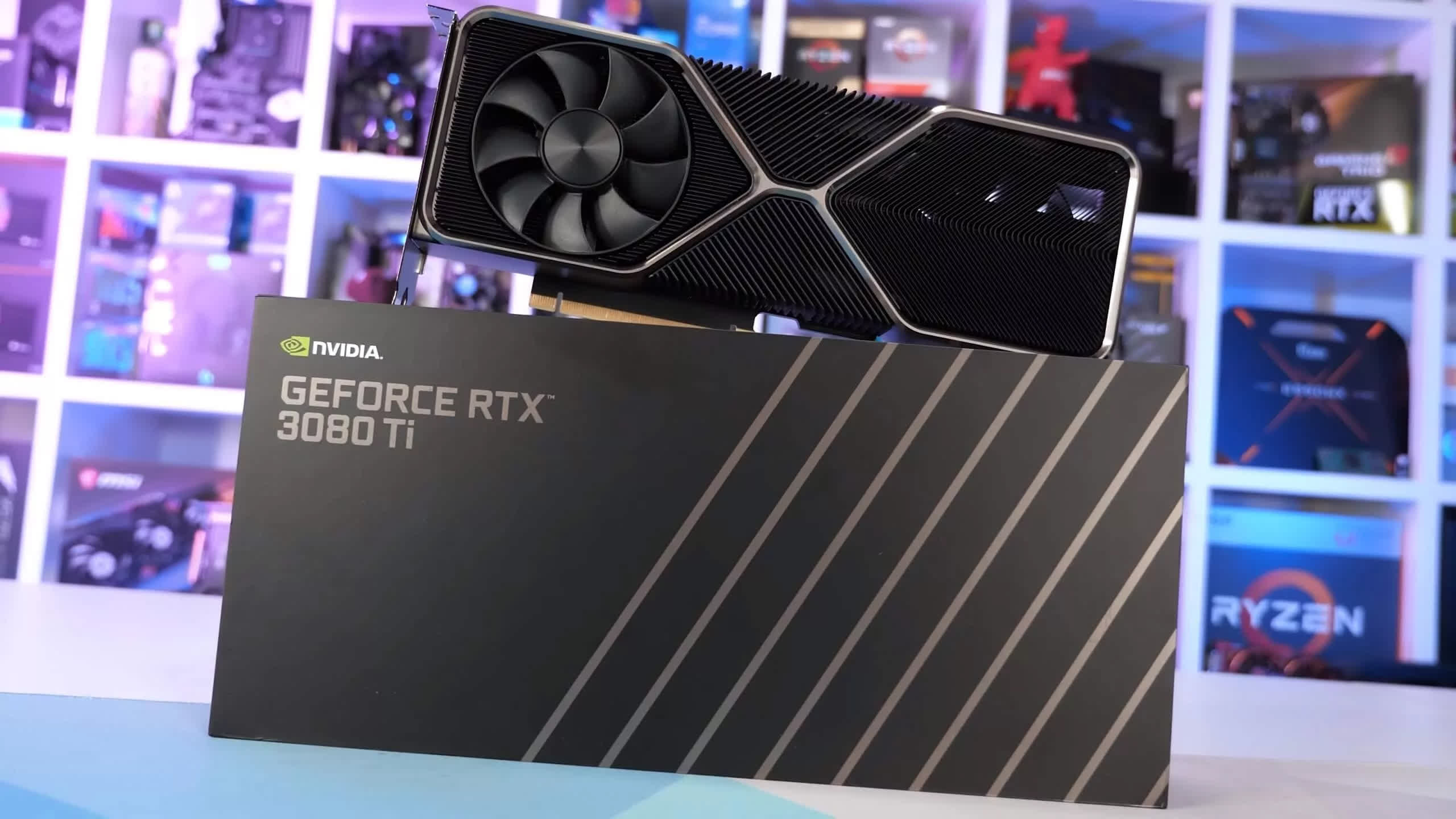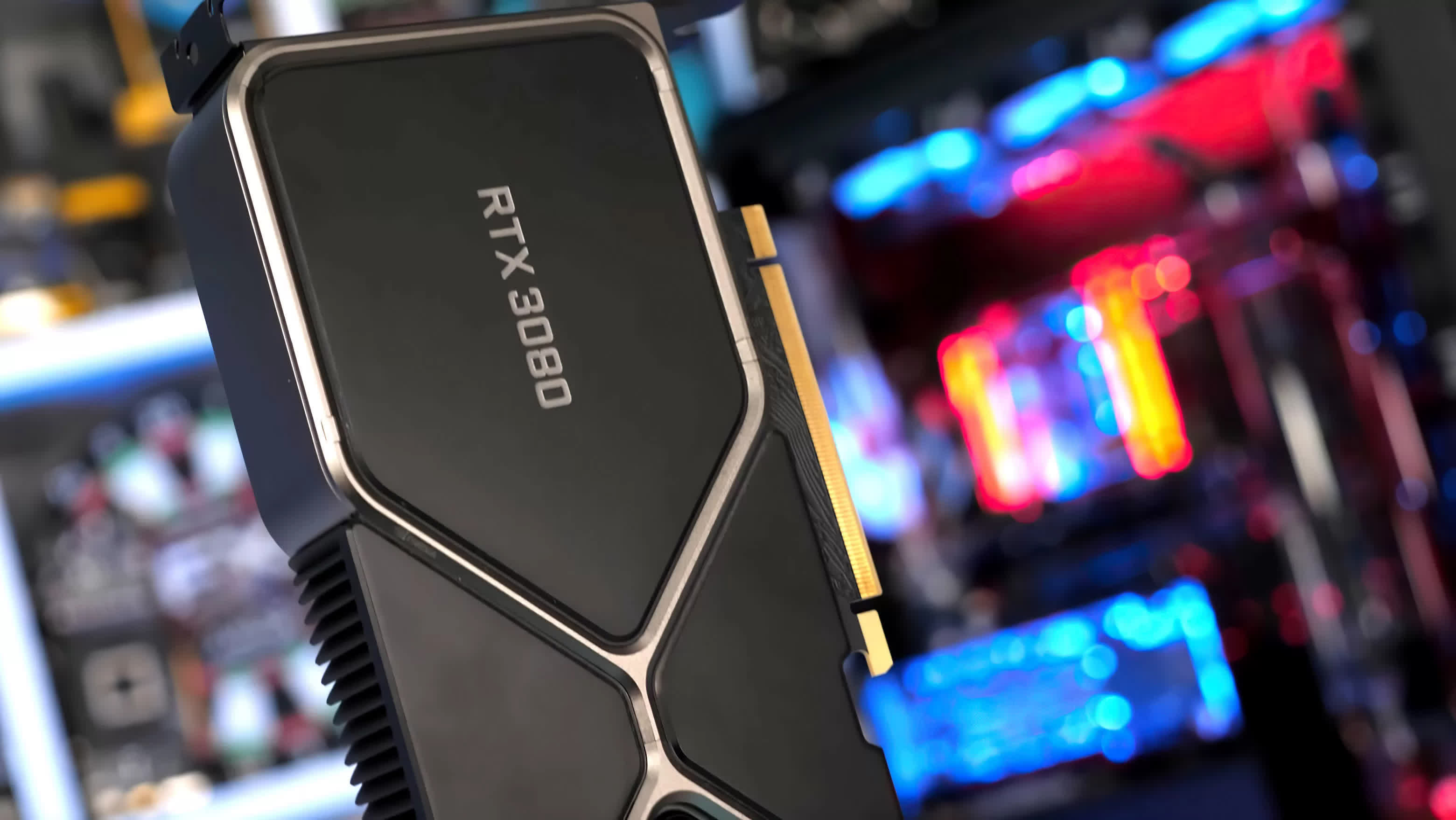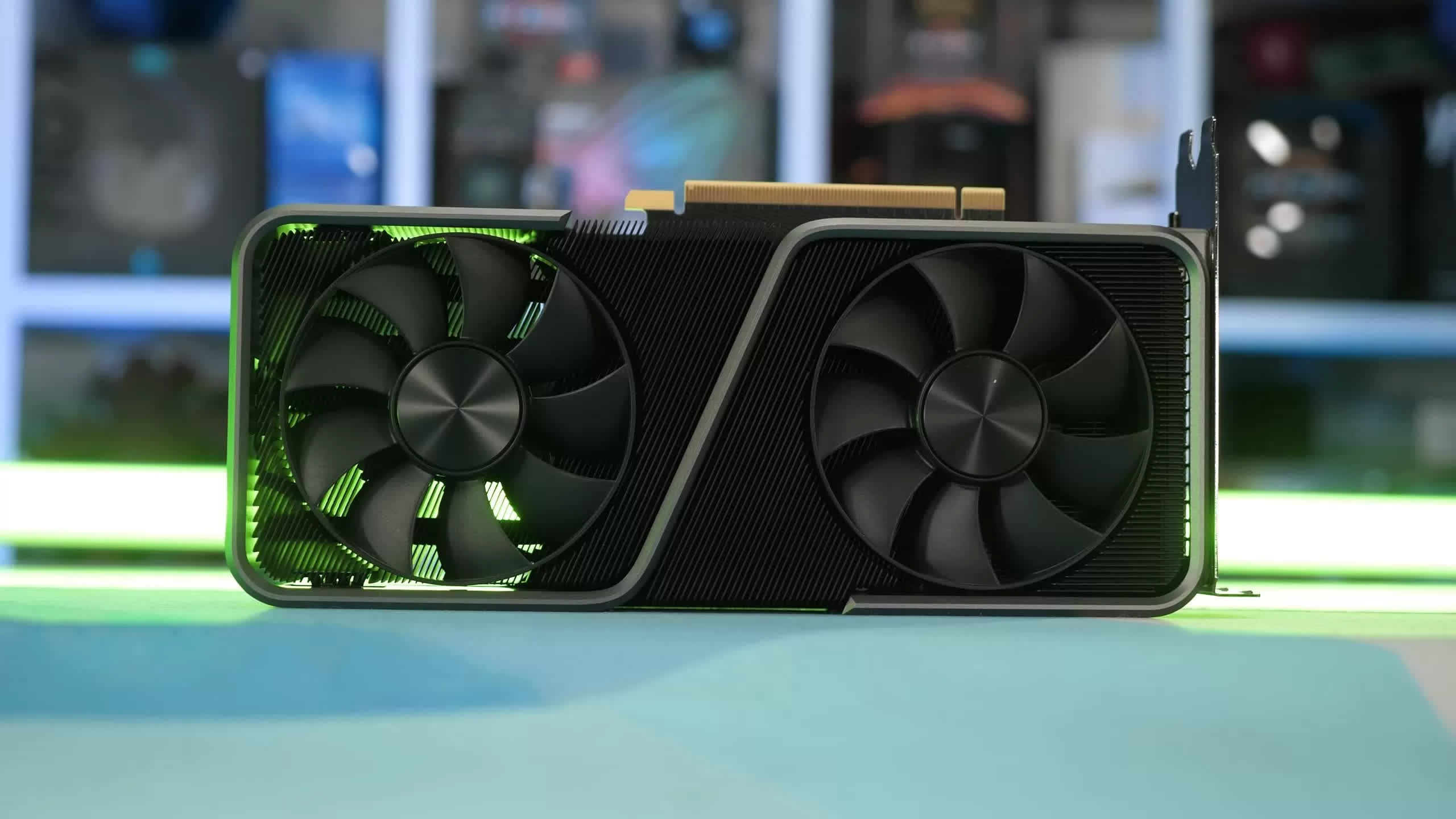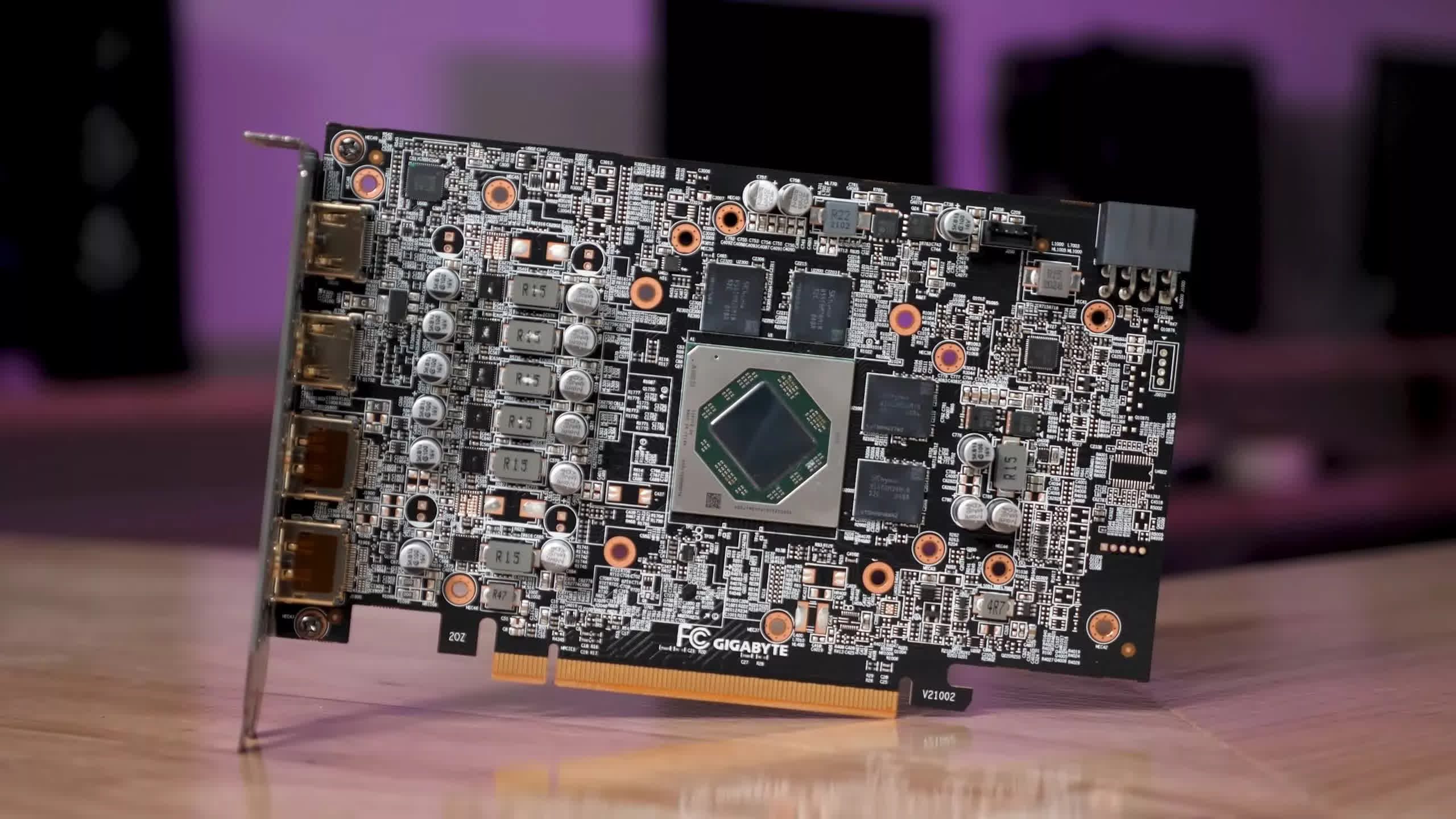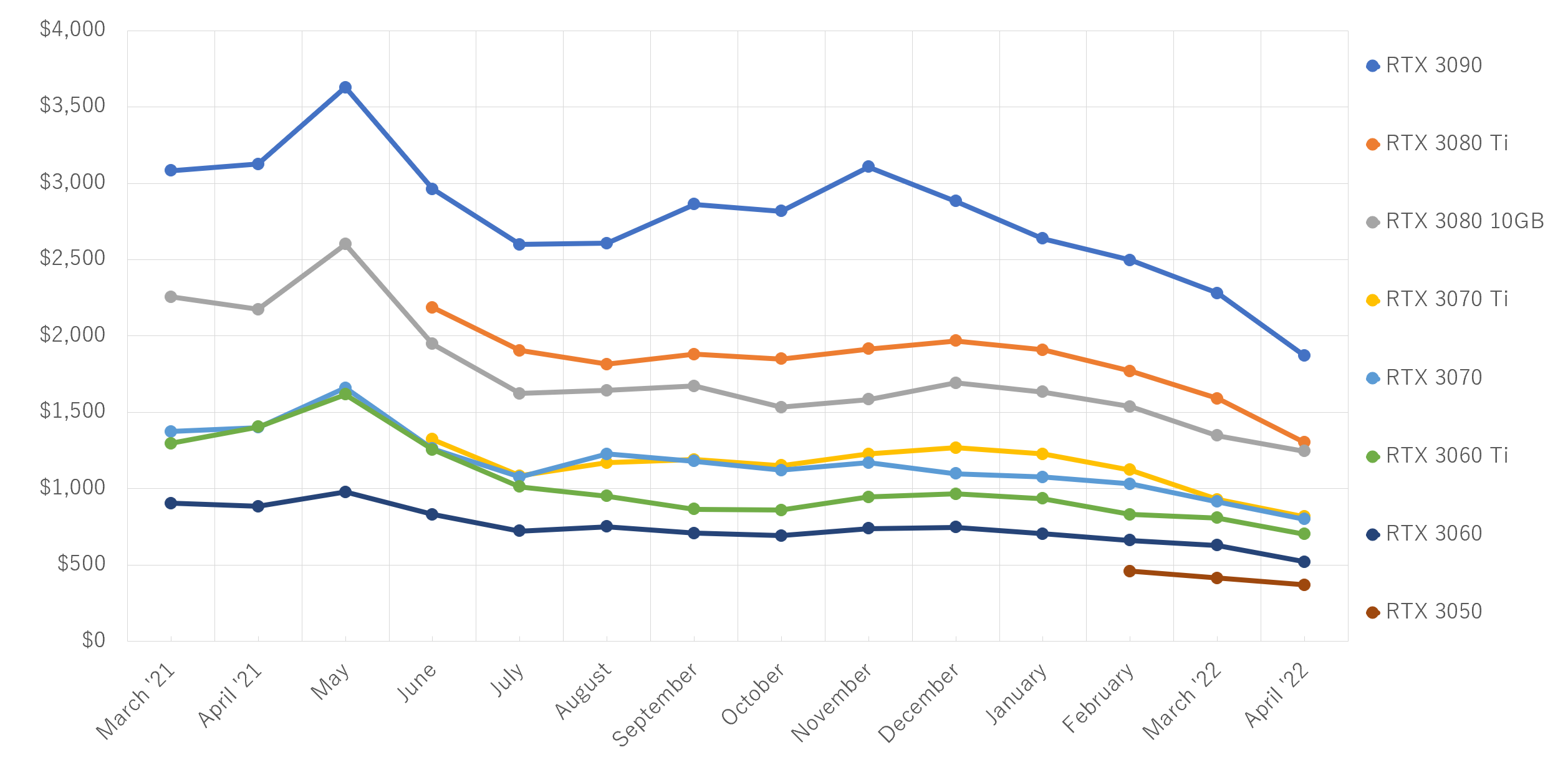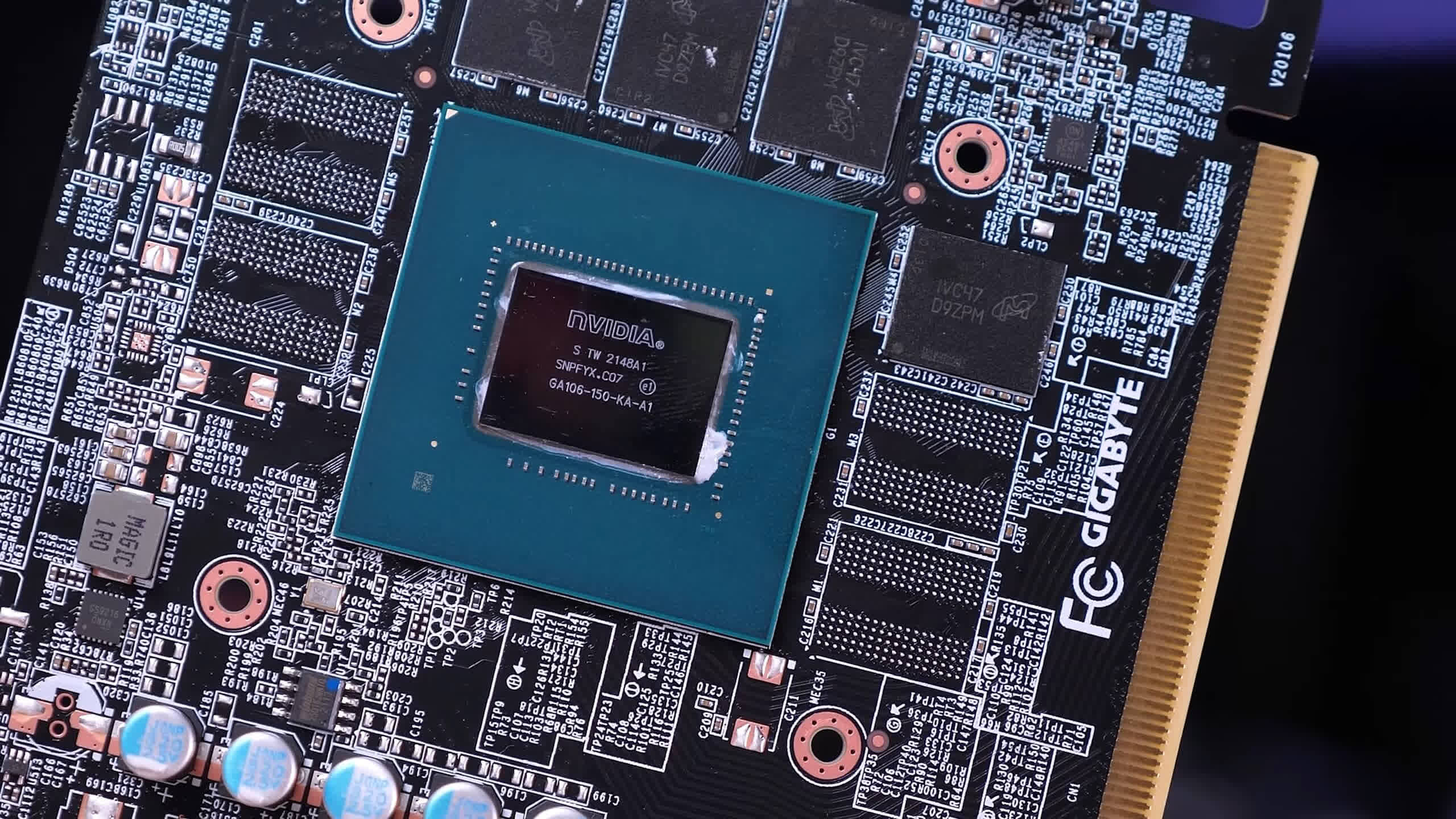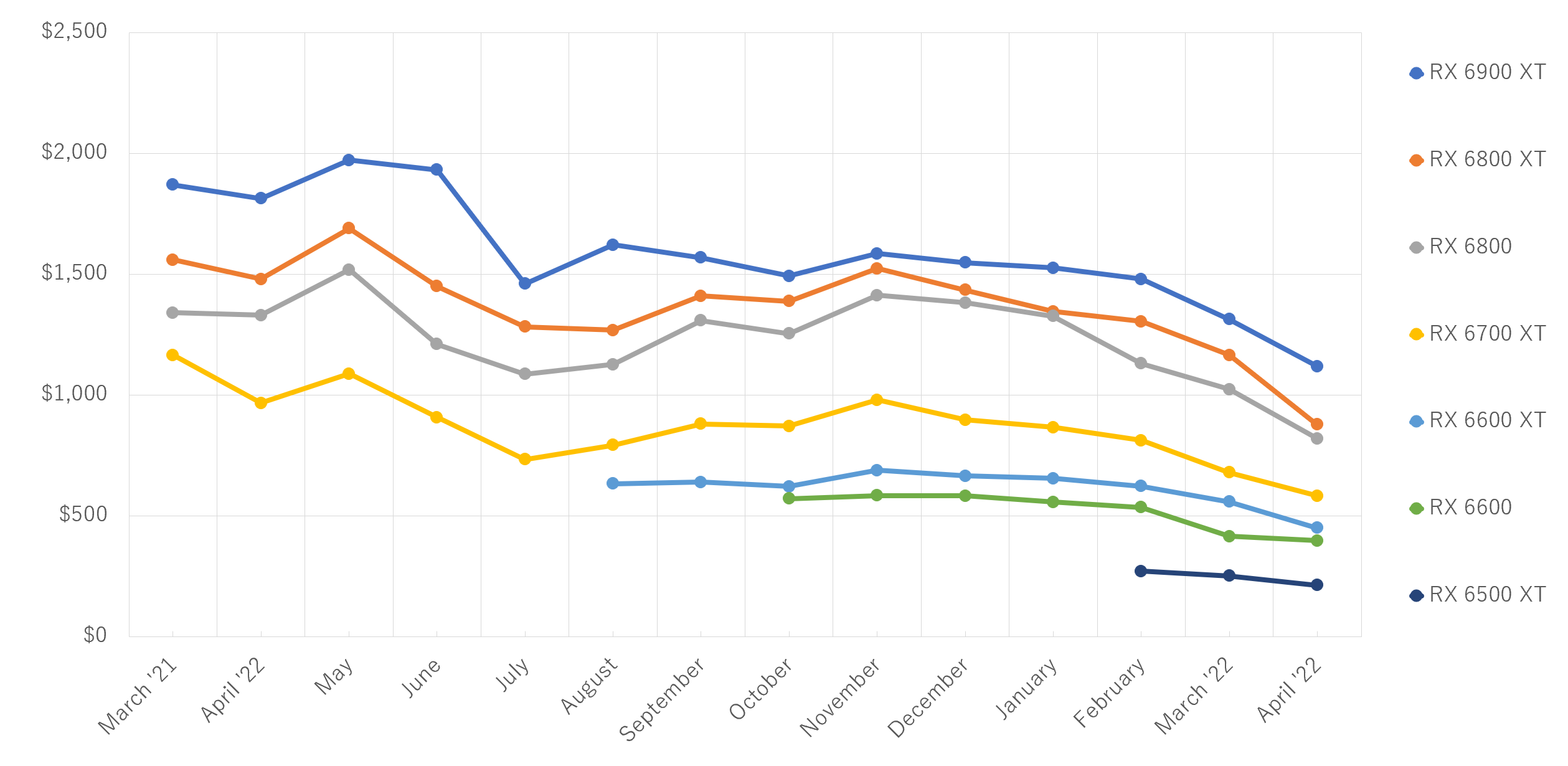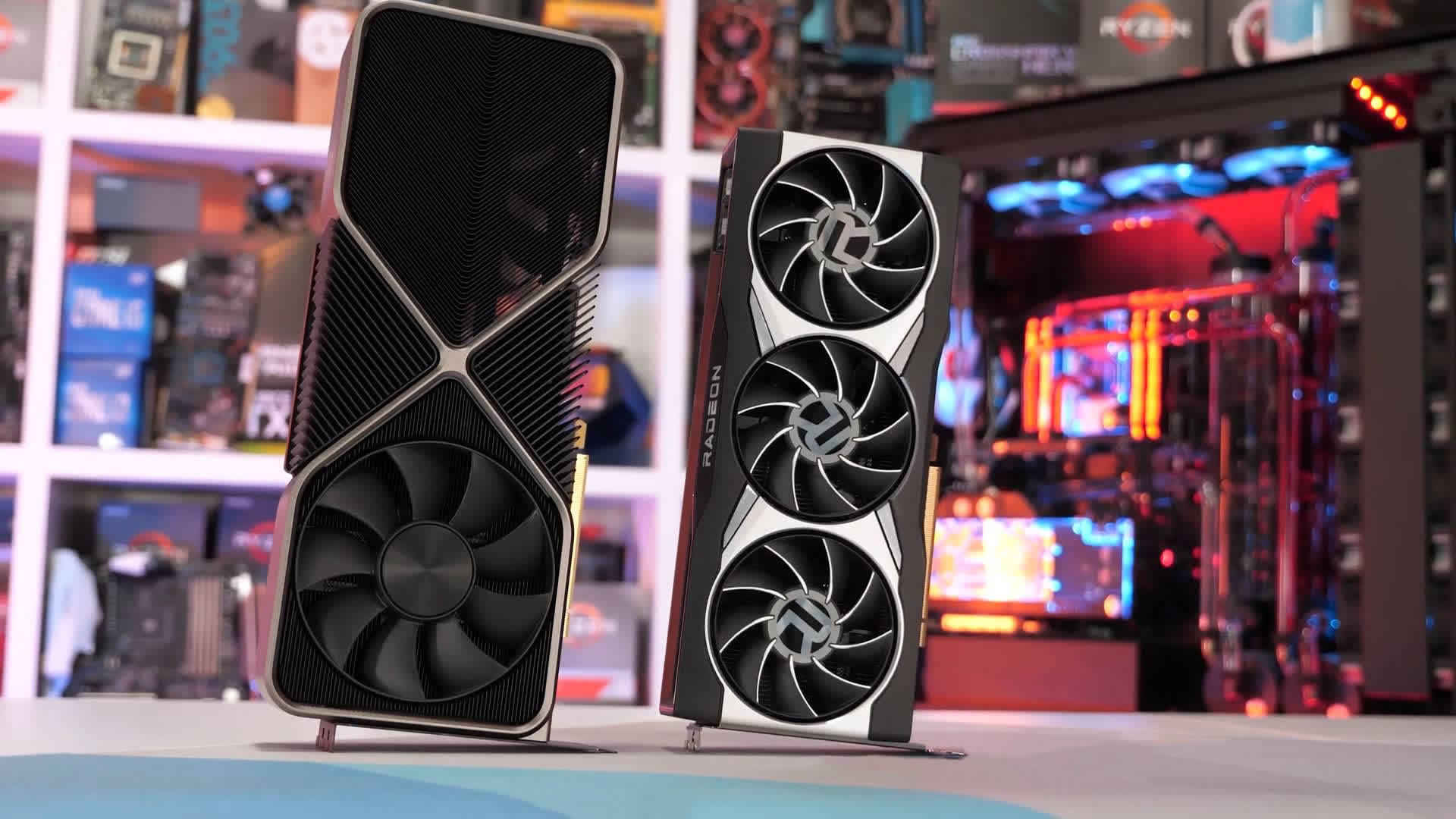It’s time for our monthly graphics card pricing update and in overly positive news, the trend towards more affordable GPUs has continued. This trend started in January and we’re inching ever closer to MSRP level pricing. We’re not there yet, but the end is in sight.
Whether MSRP pricing is good enough at this point in 2022, is an entirely different question. We’ll get to that in this article, considering that a new generation of GPUs is set to launch later this year.
One crucial indication that pricing is improving comes from, oddly enough, the hideously expensive GeForce RTX 3090 Ti. This GPU launched at $2,000 only a few weeks ago and you can currently buy it from various retailers, new and in stock, for that price.
Buying a new graphics card like this at its MSRP was completely unheard of just a year ago. The original RTX 3090 was commanding at least $2,600 on the scalper market with a peak of $3,600 at one point. Pricing has fallen considerably since, and it feels like the 3090 Ti is a bit of a last hurrah for Nvidia to squeeze what it can from from a rapidly declining market.
As has been the case for a few months now, it’s possible to buy every current-gen GPU from major retailers around the world. Availability is no longer an issue. That’s not to say the semiconductor shortage is over, as companies like TSMC still have a major crunch on supply and record high levels of demand. Estimates suggest that situation won’t change for a few more years. But these supply issues are no longer affecting graphics card pricing to the extent they once were, as the backlog of demand has cooled significantly.
A large number of gamers have been able to buy cards in the last few months, and of course, the demand from the crypto mining market has fallen off a cliff due to low profitability.
As it stands today, relatively expensive cards like the RTX 3080 Ti aren’t delivering even $3 of mining profit per day, causing the time to profit from buying one of these GPUs at the MSRP to blow out over 400 days.
GPU Pricing Update
Retail pricing at stores continues to fall. For Nvidia GPUs, last month we showed that on average, Nvidia GPUs were sitting at 50% above their MSRP for the cheapest, in stock models sold by Newegg. In April, that figure has dropped to just 28% above MSRP, thanks to a 12% drop in pricing month on month.
There is a bit of variance depending on the exact model we look at. High-end cards, in particular the GeForce RTX 3090 Ti and RTX 3080 Ti, are available at the MSRP right now. However, they also launched with inflated MSRPs, much higher than the products Nvidia launched back in 2020.
| MSRP | Lowest Price April | Price Inflation | |
|---|---|---|---|
| GeForce RTX 3090 Ti | $2,000 | $2,000 | 0% |
| GeForce RTX 3090 | $1,500 | $1,700 | 13% |
| GeForce RTX 3080 Ti | $1,200 | $1,210 | 1% |
| GeForce RTX 3080 12GB | N/A | $1,130 | N/A |
| GeForce RTX 3080 10GB | $700 | $1,000 | 43% |
| GeForce RTX 3070 Ti | $600 | $770 | 28% |
| GeForce RTX 3070 | $500 | $730 | 46% |
| GeForce RTX 3060 Ti | $400 | $580 | 45% |
| GeForce RTX 3060 | $330 | $500 | 52% |
| GeForce RTX 3050 | $250 | $315 | 26% |
| Average | 28% |
The oldest models, such as the RTX 3080 and RTX 3070, are still among the most overpriced cards in the line-up as those MSRPs are looking particularly unrealistic in the current market.
We’ve also seen larger than average falls for two GPUs in particular: the RTX 3070 and RTX 3050.
Last month, the RTX 3070 was one of the more overpriced models, sitting only $10 below the RTX 3070 Ti — making it a pointless purchase — you’d just get the Ti model. That’s been corrected now and there’s a healthier price gap between those GPUs. But it’s the RTX 3050 that’s received the largest price cut, falling 19 percent from $390 to just $315 today.
We suspect the RTX 3050’s price adjustment has come about due to pressure from AMD’s mainstream graphics cards, in particular the RX 6600, which we’ve recently been recommending in our budget mid-range build series.
AMD has been aggressively shipping RX 6600s into the market, and with its substantial performance lead over the RTX 3050 — 26% for rasterization at 1440p from our day-one review data — the RTX 3050 isn’t an attractive buy when sold at a higher price than the RX 6600.
As a result, pricing has had to fall to keep up, although there’s still a way to go before the 3050 reaches the MSRP.
| MSRP | Lowest Price April | Price Inflation | |
|---|---|---|---|
| Radeon 6900 XT | $1,000 | $1,000 | 0% |
| Radeon 6800 XT | $650 | $920 | 42% |
| Radeon 6800 | $580 | $800 | 38% |
| Radeon 6700 XT | $480 | $570 | 19% |
| Radeon 6600 XT | $380 | $440 | 16% |
| Radeon 6600 | $330 | $325 | -2% |
| Radeon 6500 XT | $200 | $210 | 5% |
| Average | 17% |
We can see more evidence of this when we look at AMD’s price data, using the same method of looking at the cheapest in-stock models at Newegg. The RX 6600 is now being sold for slightly below the MSRP, there’s an MSI model available for just $325 after a mail-in rebate, with its price coming down 19% since last month. This competition between the 6600 and RTX 3050 is great for consumers, putting serious pressure on the lower parts of the market for the first time in years.
Overall, AMD GPUs have seen less price inflation over the MSRP. Last month the average figure was 38% and now we’re down to just 17% — meaning that when combining AMD and Nvidia GPUs, current retail pricing is sitting at 25% above MSRP, the lowest rate we’ve seen since this latest generation graphics cards launched.
AMD cards fell in price by 15%, including substantial drops for high-end cards. The RX 6900 XT is now available at its $1,000 MSRP after factoring in mail-in rebates. That puts it at the same price as Nvidia’s RTX 3080, which again is great for competition.
Nvidia GPU Pricing Trend
Average Sale Price of eBay Completed Listings, New Products, 3rd Week of Month
We’ve just been talking about crucial battles at $300 between the RTX 3050 and RX 6600; and at $1,000 with the RTX 3080 and RX 6900 XT — but the two brands are competitive elsewhere.
Just recently we checked out how the RTX 3060 Ti stacks up against the RX 6700 XT at roughly the same price, around $580, and came to the conclusion that the GeForce product is the better buy.
AMD would need to further lower prices and get closer to the $480 MSRP for the 6700 XT to be a great option, which we expect to happen due to fierce competition right now.
| MSRP | eBay Average Price February | eBay Average Price March | eBay Average Price April | Current Price Inflation | Price Increase Mar to April | |
|---|---|---|---|---|---|---|
| GeForce RTX 3090 | $1,500 | $2,496 | $2,281 | $1,870 | 25% | -18% |
| GeForce RTX 3080 Ti | $1,200 | $1,771 | $1,590 | $1,303 | 9% | -18% |
| GeForce RTX 3080 12GB | N/A | $1,623 | $1,360 | $1,045 | -23% | |
| GeForce RTX 3080 10GB | $700 | $1,538 | $1,348 | $1,245 | 78% | -8% |
| GeForce RTX 3070 Ti | $600 | $1,123 | $929 | $817 | 36% | -12% |
| GeForce RTX 3070 | $500 | $1,030 | $915 | $801 | 60% | -12% |
| GeForce RTX 3060 Ti | $400 | $831 | $808 | $703 | 76% | -13% |
| GeForce RTX 3060 | $330 | $662 | $628 | $521 | 58% | -17% |
| GeForce RTX 3050 | $250 | $460 | $414 | $369 | 48% | -11% |
| Average | 49% | -15% |
With prices falling by 13% on average month on month, we’re actually at the point where GPUs at the MSRP are within reach for the majority of models.
We are already seeing some cards back at their launch price, and we’re only a month or two away from the same occurring with other cards if the pace of price reductions keeps up. We’d expect cards like the RTX 3090, RTX 3050, RX 6700 XT and RX 6600 XT to all hit MSRP relatively shortly.
The major issue for buyers holding out for that sweet MSRP goodness are the cards that launched in 2020 with pricing set for a totally different market. There are six cards across Nvidia and AMD’s lineups that are sitting with price inflation above 30%, and we think it’s unlikely that pricing for those models will hit MSRP soon.
Yes, we do expect pricing to get better over time, but $500 RTX 3070s when the current price is $730 seems out of reach for now, save for the occasional hot price discount.
As we discussed last month, the resurgence of the legitimate retail market for new graphics cards has crippled the scalper market on eBay. Pricing continues to fall for used graphics cards on eBay, in line with the reductions seen at retailers, but it still doesn’t make much sense to buy a card from some random person on eBay when pricing is the same as proper retailers, or even higher in some instances. We’d choose the full service of a retailer over a scalper every day, especially when prices are lower, as dealing with returns will be a much easier process.
AMD GPU Pricing Trend
Average Sale Price of eBay Completed Listings, New Products, 3rd Week of Month
| MSRP | eBay Average Price February | eBay Average Price March | eBay Average Price April | Current Price Inflation | Price Increase Mar to April | |
|---|---|---|---|---|---|---|
| GeForce RTX 2080 Ti | $1,000 | $941 | $843 | $749 | -25% | -11% |
| GeForce RTX 2080 Super | $700 | $742 | $661 | $547 | -22% | -17% |
| GeForce RTX 2080 | $700 | $650 | $610 | $465 | -34% | -24% |
| GeForce RTX 2070 Super | $500 | $625 | $566 | $470 | -6% | -17% |
| GeForce RTX 2070 | $500 | $580 | $501 | $413 | -17% | -17% |
| GeForce RTX 2060 Super | $400 | $562 | $494 | $439 | 10% | -11% |
| GeForce RTX 2060 | $350 | $429 | $369 | $313 | -11% | -15% |
| Average | -15% | -16% |
When new GPUs fall in price, so do used GPUs on eBay. The GeForce 20 series fell in price by 16 percent on average and now only the RTX 2060 Super sits above its launch MSRP.
Cards like the RTX 2080 have fallen substantially in value over the last few months due to pressure in the mid-range, particularly from the RTX 3060 Ti and RTX 3060. Meanwhile the RTX 2060 is falling in line with the retail market aggressively dropping the price for the RTX 3050 and RX 6600.
| MSRP | eBay Average Price February | eBay Average Price March | eBay Average Price April | Current Price Inflation | Price Increase Mar to April | |
|---|---|---|---|---|---|---|
| GeForce GTX 1660 Ti | $280 | $394 | $364 | $295 | 5% | -19% |
| GeForce GTX 1660 Super | $230 | $411 | $349 | $299 | 30% | -14% |
| GeForce GTX 1660 | $220 | $335 | $305 | $234 | 6% | -23% |
| GeForce GTX 1650 Super | $160 | $272 | $220 | $192 | 20% | -13% |
| GeForce GTX 1650 | $150 | $213 | $197 | $181 | 21% | -8% |
| Average | 17% | -15% |
It’s great to see a lot of price movement for the GeForce 16 series, driven once again by strong competition for new GPUs in the $300 market. With that said, a lot of these used GPUs don’t make any sense, especially the GTX 1660 Super, which for used models costs just $15 less than the RTX 3050 but is slower and lacks features like DLSS and ray tracing. In today’s market, these models should cost no more than the MSRP, otherwise they simply aren’t worth it.
| MSRP | eBay Average Price February | eBay Average Price March | eBay Average Price April | Current Price Inflation | Price Increase Mar to April | |
|---|---|---|---|---|---|---|
| GeForce GTX 1080 Ti | $700 | $561 | $486 | $394 | -44% | -19% |
| GeForce GTX 1080 | $600 | $384 | $349 | $284 | -53% | -19% |
| GeForce GTX 1070 Ti | $450 | $393 | $331 | $277 | -39% | -16% |
| GeForce GTX 1070 | $380 | $307 | $281 | $223 | -41% | -21% |
| GeForce GTX 1060 6GB | $250 | $256 | $234 | $163 | -35% | -30% |
| GeForce GTX 1060 3GB | $200 | $178 | $166 | $146 | -27% | -12% |
| Average | -40% | -19% |
Owners of Nvidia Pascal era GPUs are dumping them on eBay at the moment. This series saw the highest month on month price drops, 19% on average which is substantial.
It’s good to see that all Pascal cards are now well below MSRP, which makes sense given their age. We don’t think it’s worth investing in a 10 series card at the moment, aside from use as a cheap stopgap option, because they’re too old at this point.
| MSRP | eBay Average Price February | eBay Average Price March | eBay Average Price April | Current Price Inflation | Price Increase Mar to April | |
|---|---|---|---|---|---|---|
| Radeon 5700 XT | $400 | $714 | $581 | $516 | 29% | -11% |
| Radeon 5700 | $350 | $664 | $544 | $492 | 41% | -9% |
| Radeon 5600 XT | $280 | $480 | $395 | $355 | 27% | -10% |
| Radeon 5500 XT 8GB | $200 | $341 | $283 | $236 | 18% | -16% |
| Average | 29% | -12% |
AMD’s Radeon RX 5000 series saw more modest price drops than Nvidia’s last-generation series, falling by 12% on average. However since the start of the year, these cards have fallen off a cliff.
The RX 5700 XT was selling for $900 in mid December, and today they’re just a touch over $500. That’s how much impact the reduction in mining profitability has had, along with improved availability for current-gen cards. Like with the GeForce 16 series, it doesn’t make sense for a gamer to buy one of these over a new product.
| MSRP | eBay Average Price February | eBay Average Price March | eBay Average Price April | Current Price Inflation | Price Increase Mar to April | |
|---|---|---|---|---|---|---|
| Radeon RX Vega 64 | $500 | $563 | $425 | $416 | -17% | -2% |
| Radeon RX Vega 56 | $400 | $519 | $419 | $415 | 4% | -1% |
| Radeon RX 590 | $280 | $341 | $315 | $269 | -4% | -15% |
| Radeon RX 580 8GB | $230 | $340 | $267 | $257 | 12% | -4% |
| Radeon RX 580 4GB | $200 | $206 | $184 | $167 | -16% | -9% |
| Radeon RX 570 4GB | $170 | $183 | $166 | $147 | -14% | -11% |
| Average | -6% | -7% |
Then we get to AMD’s older GPUs. Vega cards have received the same large price corrections since the beginning of the year, but only fell slightly this month. Meanwhile, the Polaris series has seen more typical price drops, though a lot of these cards aren’t worth buying as a stopgap, aside from maybe the RX 570. For example, I would personally choose a GTX 1650 Super for $190 used over an RX 580 8GB for $260 as they’re both similar enough in performance.
Should You Buy a New GPU Right Now?
Overall, what we’re seeing across this month for GPU pricing is great news. April saw the largest reduction in GPU pricing of the year: in January we saw a ~5% drop, growing to around 8% in February, 12% in March, and now we’ve seen an additional 15% drop for both new and used graphics cards.
Some GPUs are currently available at the MSRP, and a bunch more will hit the MSRP within a month or two if the current trend continues. These are positive signs and we think it’s safe to say the pricing woes of 2021 are behind us now, at least until next-generation GPUs launch.
With a new generation of GPUs on the horizon though, one of the key remaining questions is whether MSRP-level pricing is good enough for products that launched as far back as September 2020. We think this will depend on what sort of GPU you are interested in buying, and of course, your current situation, as we’re sure many gamers are desperate and are not willing to keep waiting another six months or more.
Assuming you do have the capacity to wait, we think this situation can be split in two segments of the market. Right now it doesn’t make much sense for high-end buyers to splurge big cash on current-gen GPUs at or above the MSRP. When next-gen GPUs launch, AMD and especially Nvidia will likely release high-end products first. This will cause those top-end, poor value products to quickly lose their status in the market.
A GPU like the RTX 3090 Ti, which just launched for $2,000, could be superseded later this year by something faster at a similar price. It’d make more sense for that sort of buyer to settle on an RTX 3080 at $1,000, but even products around that sort of price point are likely to be replaced.
So it’s a bit tricky and we don’t think cards with MSRPs over $700 are a sensible purchase at the moment with pricing as it is right now. We’d really like to see that RTX 3080 get much closer to $700.
As for budget to mid-range GPUs… these are unlikely to be replaced any time soon. Remember how long the wait was for cards like the RTX 3050 and RX 6600?
The RTX 3050 launched 16 months after the RTX 3090, and the RX 6600 was 11 months after the RX 6800 XT. This generation was not the only one where mainstream products took ages to finally launch. With the Turing and RDNA generations, it took both AMD and Nvidia around 6 months to launch sub-$300 GPUs, and that was in a regular market.
In other words, a replacement for a GPU such as the RTX 3060 is likely more than a year away. We’d have no trouble recommending people grab mainstream GPU models at the moment — maybe not the RTX 3060 specifically because it’s still heavily inflated — but cards like the RX 6600 XT and RTX 3050 are unlikely to become old news within a year.
Even when newer high-end cards launch, mainstream GPUs will still be sold in the $300 range, just like Nvidia did with the GeForce 16 series after Ampere launched. You might see a bit lower pricing if you continue to hold out, but substantial price to performance improvements aren’t on the immediate horizon.
Shopping Shortcuts:
- Nvidia GeForce RTX 3070 Ti on Amazon
- Nvidia GeForce RTX 3060 on Amazon
- Nvidia GeForce RTX 3090 Ti on Amazon
- Nvidia GeForce RTX 3090 on Amazon
- AMD Radeon RX 6900 XT on Amazon
- AMD Radeon RX 6600 XT on Amazon
- Nvidia GeForce RTX 3080 on Amazon
- Intel Core i5-12600K on Amazon
- AMD Ryzen 9 5950X on Amazon
- AMD Ryzen 7 5800X on Amazon


